Global Finance Report: Funding Options, FX Risk, and Derivatives
VerifiedAdded on 2022/08/14
|13
|3603
|11
Report
AI Summary
This report provides a comprehensive overview of global finance, focusing on funding options and the use of derivatives to manage foreign exchange (FX) risk. The first part of the report explores various funding sources available in the global financial market, including equity shares, debentures, conventional loans, bonds, and commercial paper, with a focus on raising GBP 50 million. The second part delves into different types of derivatives, such as forward contracts, future contracts, options contracts, and swap contracts, comparing their advantages and disadvantages in mitigating FX risk. The report highlights the importance of derivatives in the volatile global financial market and examines the characteristics and applications of each derivative type, providing a detailed analysis for financial decision-making.
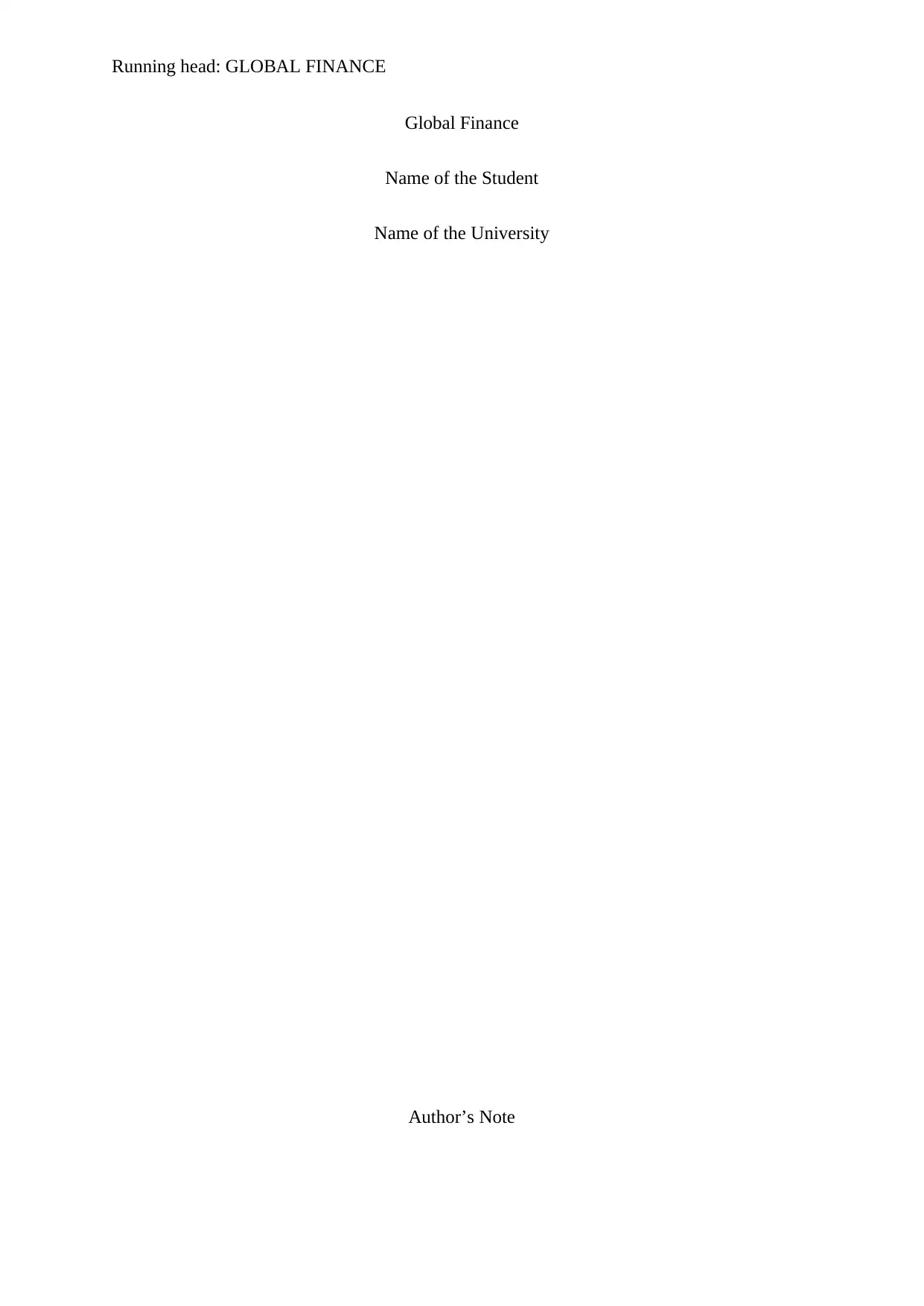
Running head: GLOBAL FINANCE
Global Finance
Name of the Student
Name of the University
Author’s Note
Global Finance
Name of the Student
Name of the University
Author’s Note
Paraphrase This Document
Need a fresh take? Get an instant paraphrase of this document with our AI Paraphraser

1GLOBAL FINANCE
Table of Contents
Introduction................................................................................................................................2
Part 1: Review of Main Funding Options..................................................................................2
Part 2: Critical Discussion and Comparison on the Use of Derivatives....................................5
Forward contracts...................................................................................................................5
Future contracts......................................................................................................................6
Options contracts....................................................................................................................7
Swap contracts.......................................................................................................................8
Conclusion................................................................................................................................10
References................................................................................................................................11
Table of Contents
Introduction................................................................................................................................2
Part 1: Review of Main Funding Options..................................................................................2
Part 2: Critical Discussion and Comparison on the Use of Derivatives....................................5
Forward contracts...................................................................................................................5
Future contracts......................................................................................................................6
Options contracts....................................................................................................................7
Swap contracts.......................................................................................................................8
Conclusion................................................................................................................................10
References................................................................................................................................11
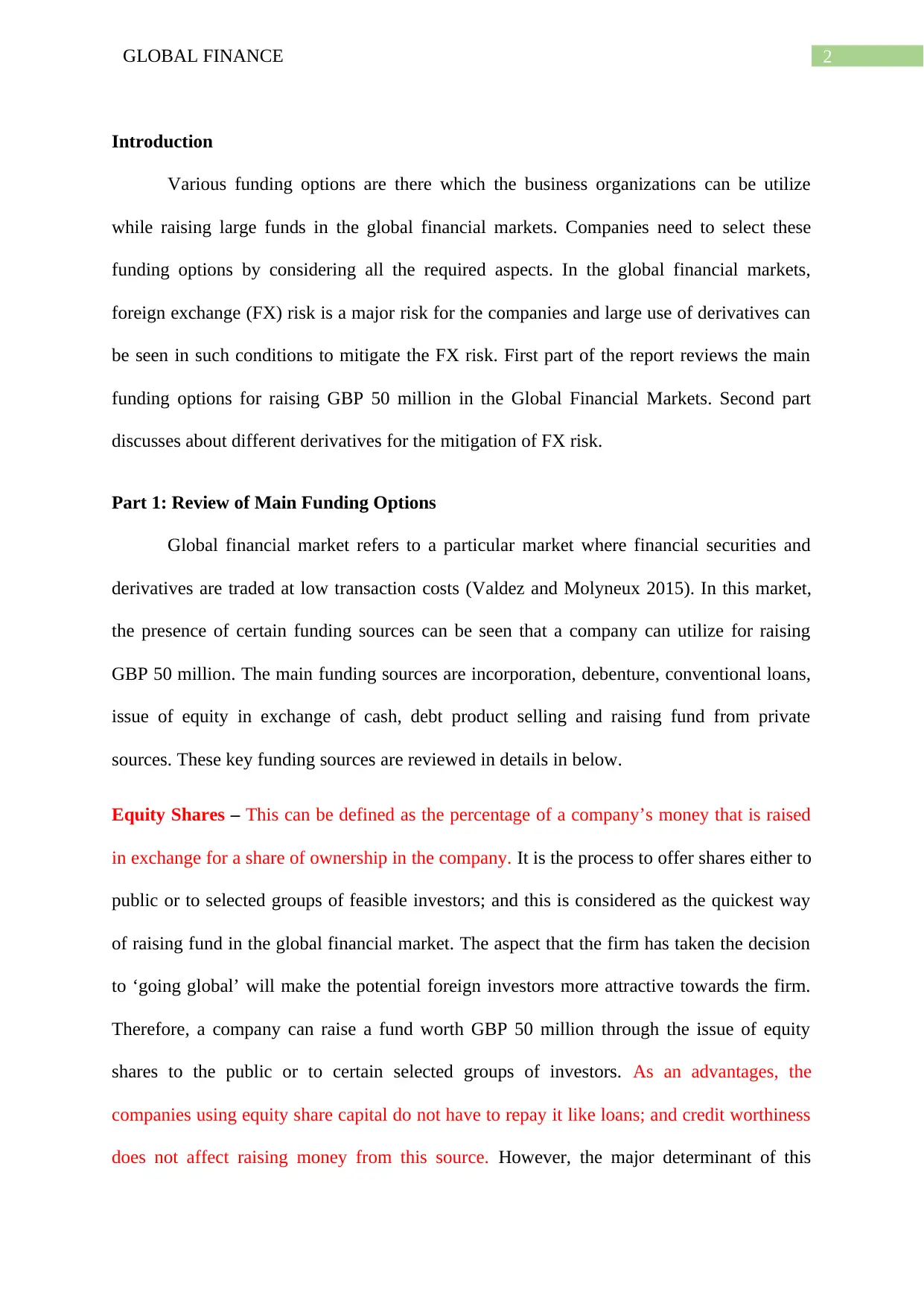
2GLOBAL FINANCE
Introduction
Various funding options are there which the business organizations can be utilize
while raising large funds in the global financial markets. Companies need to select these
funding options by considering all the required aspects. In the global financial markets,
foreign exchange (FX) risk is a major risk for the companies and large use of derivatives can
be seen in such conditions to mitigate the FX risk. First part of the report reviews the main
funding options for raising GBP 50 million in the Global Financial Markets. Second part
discusses about different derivatives for the mitigation of FX risk.
Part 1: Review of Main Funding Options
Global financial market refers to a particular market where financial securities and
derivatives are traded at low transaction costs (Valdez and Molyneux 2015). In this market,
the presence of certain funding sources can be seen that a company can utilize for raising
GBP 50 million. The main funding sources are incorporation, debenture, conventional loans,
issue of equity in exchange of cash, debt product selling and raising fund from private
sources. These key funding sources are reviewed in details in below.
Equity Shares – This can be defined as the percentage of a company’s money that is raised
in exchange for a share of ownership in the company. It is the process to offer shares either to
public or to selected groups of feasible investors; and this is considered as the quickest way
of raising fund in the global financial market. The aspect that the firm has taken the decision
to ‘going global’ will make the potential foreign investors more attractive towards the firm.
Therefore, a company can raise a fund worth GBP 50 million through the issue of equity
shares to the public or to certain selected groups of investors. As an advantages, the
companies using equity share capital do not have to repay it like loans; and credit worthiness
does not affect raising money from this source. However, the major determinant of this
Introduction
Various funding options are there which the business organizations can be utilize
while raising large funds in the global financial markets. Companies need to select these
funding options by considering all the required aspects. In the global financial markets,
foreign exchange (FX) risk is a major risk for the companies and large use of derivatives can
be seen in such conditions to mitigate the FX risk. First part of the report reviews the main
funding options for raising GBP 50 million in the Global Financial Markets. Second part
discusses about different derivatives for the mitigation of FX risk.
Part 1: Review of Main Funding Options
Global financial market refers to a particular market where financial securities and
derivatives are traded at low transaction costs (Valdez and Molyneux 2015). In this market,
the presence of certain funding sources can be seen that a company can utilize for raising
GBP 50 million. The main funding sources are incorporation, debenture, conventional loans,
issue of equity in exchange of cash, debt product selling and raising fund from private
sources. These key funding sources are reviewed in details in below.
Equity Shares – This can be defined as the percentage of a company’s money that is raised
in exchange for a share of ownership in the company. It is the process to offer shares either to
public or to selected groups of feasible investors; and this is considered as the quickest way
of raising fund in the global financial market. The aspect that the firm has taken the decision
to ‘going global’ will make the potential foreign investors more attractive towards the firm.
Therefore, a company can raise a fund worth GBP 50 million through the issue of equity
shares to the public or to certain selected groups of investors. As an advantages, the
companies using equity share capital do not have to repay it like loans; and credit worthiness
does not affect raising money from this source. However, the major determinant of this
⊘ This is a preview!⊘
Do you want full access?
Subscribe today to unlock all pages.

Trusted by 1+ million students worldwide
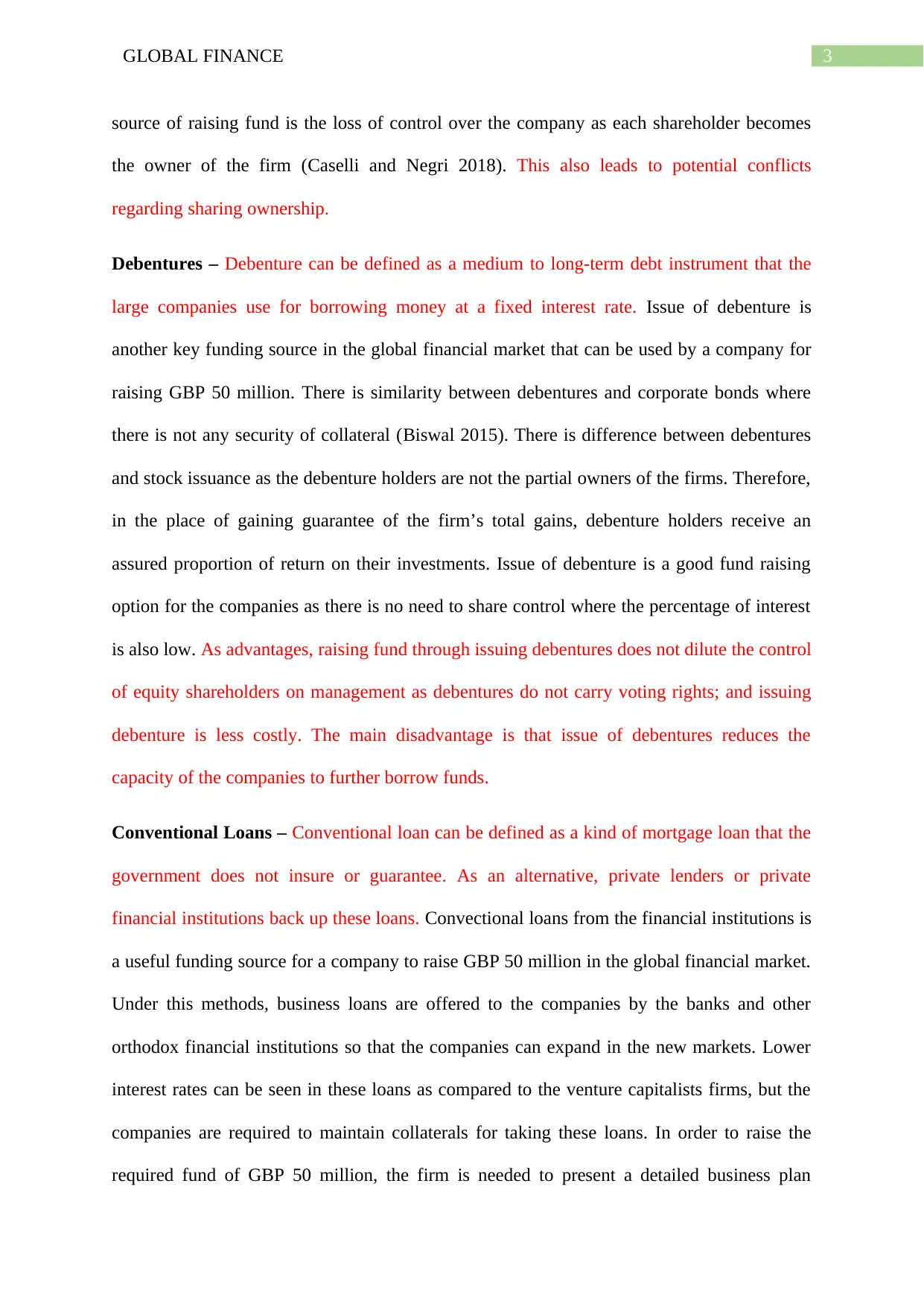
3GLOBAL FINANCE
source of raising fund is the loss of control over the company as each shareholder becomes
the owner of the firm (Caselli and Negri 2018). This also leads to potential conflicts
regarding sharing ownership.
Debentures – Debenture can be defined as a medium to long-term debt instrument that the
large companies use for borrowing money at a fixed interest rate. Issue of debenture is
another key funding source in the global financial market that can be used by a company for
raising GBP 50 million. There is similarity between debentures and corporate bonds where
there is not any security of collateral (Biswal 2015). There is difference between debentures
and stock issuance as the debenture holders are not the partial owners of the firms. Therefore,
in the place of gaining guarantee of the firm’s total gains, debenture holders receive an
assured proportion of return on their investments. Issue of debenture is a good fund raising
option for the companies as there is no need to share control where the percentage of interest
is also low. As advantages, raising fund through issuing debentures does not dilute the control
of equity shareholders on management as debentures do not carry voting rights; and issuing
debenture is less costly. The main disadvantage is that issue of debentures reduces the
capacity of the companies to further borrow funds.
Conventional Loans – Conventional loan can be defined as a kind of mortgage loan that the
government does not insure or guarantee. As an alternative, private lenders or private
financial institutions back up these loans. Convectional loans from the financial institutions is
a useful funding source for a company to raise GBP 50 million in the global financial market.
Under this methods, business loans are offered to the companies by the banks and other
orthodox financial institutions so that the companies can expand in the new markets. Lower
interest rates can be seen in these loans as compared to the venture capitalists firms, but the
companies are required to maintain collaterals for taking these loans. In order to raise the
required fund of GBP 50 million, the firm is needed to present a detailed business plan
source of raising fund is the loss of control over the company as each shareholder becomes
the owner of the firm (Caselli and Negri 2018). This also leads to potential conflicts
regarding sharing ownership.
Debentures – Debenture can be defined as a medium to long-term debt instrument that the
large companies use for borrowing money at a fixed interest rate. Issue of debenture is
another key funding source in the global financial market that can be used by a company for
raising GBP 50 million. There is similarity between debentures and corporate bonds where
there is not any security of collateral (Biswal 2015). There is difference between debentures
and stock issuance as the debenture holders are not the partial owners of the firms. Therefore,
in the place of gaining guarantee of the firm’s total gains, debenture holders receive an
assured proportion of return on their investments. Issue of debenture is a good fund raising
option for the companies as there is no need to share control where the percentage of interest
is also low. As advantages, raising fund through issuing debentures does not dilute the control
of equity shareholders on management as debentures do not carry voting rights; and issuing
debenture is less costly. The main disadvantage is that issue of debentures reduces the
capacity of the companies to further borrow funds.
Conventional Loans – Conventional loan can be defined as a kind of mortgage loan that the
government does not insure or guarantee. As an alternative, private lenders or private
financial institutions back up these loans. Convectional loans from the financial institutions is
a useful funding source for a company to raise GBP 50 million in the global financial market.
Under this methods, business loans are offered to the companies by the banks and other
orthodox financial institutions so that the companies can expand in the new markets. Lower
interest rates can be seen in these loans as compared to the venture capitalists firms, but the
companies are required to maintain collaterals for taking these loans. In order to raise the
required fund of GBP 50 million, the firm is needed to present a detailed business plan
Paraphrase This Document
Need a fresh take? Get an instant paraphrase of this document with our AI Paraphraser
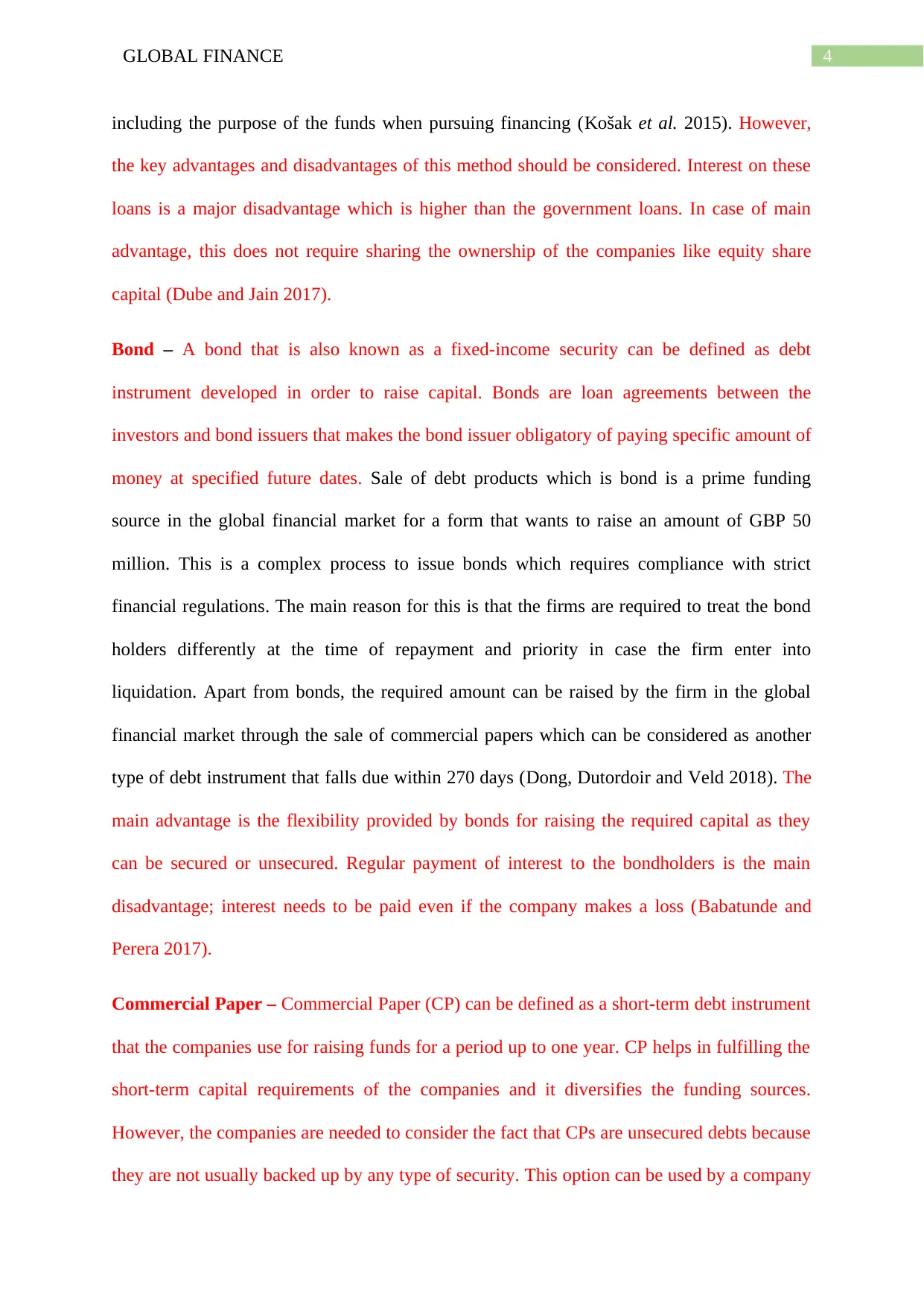
4GLOBAL FINANCE
including the purpose of the funds when pursuing financing (Košak et al. 2015). However,
the key advantages and disadvantages of this method should be considered. Interest on these
loans is a major disadvantage which is higher than the government loans. In case of main
advantage, this does not require sharing the ownership of the companies like equity share
capital (Dube and Jain 2017).
Bond – A bond that is also known as a fixed-income security can be defined as debt
instrument developed in order to raise capital. Bonds are loan agreements between the
investors and bond issuers that makes the bond issuer obligatory of paying specific amount of
money at specified future dates. Sale of debt products which is bond is a prime funding
source in the global financial market for a form that wants to raise an amount of GBP 50
million. This is a complex process to issue bonds which requires compliance with strict
financial regulations. The main reason for this is that the firms are required to treat the bond
holders differently at the time of repayment and priority in case the firm enter into
liquidation. Apart from bonds, the required amount can be raised by the firm in the global
financial market through the sale of commercial papers which can be considered as another
type of debt instrument that falls due within 270 days (Dong, Dutordoir and Veld 2018). The
main advantage is the flexibility provided by bonds for raising the required capital as they
can be secured or unsecured. Regular payment of interest to the bondholders is the main
disadvantage; interest needs to be paid even if the company makes a loss (Babatunde and
Perera 2017).
Commercial Paper – Commercial Paper (CP) can be defined as a short-term debt instrument
that the companies use for raising funds for a period up to one year. CP helps in fulfilling the
short-term capital requirements of the companies and it diversifies the funding sources.
However, the companies are needed to consider the fact that CPs are unsecured debts because
they are not usually backed up by any type of security. This option can be used by a company
including the purpose of the funds when pursuing financing (Košak et al. 2015). However,
the key advantages and disadvantages of this method should be considered. Interest on these
loans is a major disadvantage which is higher than the government loans. In case of main
advantage, this does not require sharing the ownership of the companies like equity share
capital (Dube and Jain 2017).
Bond – A bond that is also known as a fixed-income security can be defined as debt
instrument developed in order to raise capital. Bonds are loan agreements between the
investors and bond issuers that makes the bond issuer obligatory of paying specific amount of
money at specified future dates. Sale of debt products which is bond is a prime funding
source in the global financial market for a form that wants to raise an amount of GBP 50
million. This is a complex process to issue bonds which requires compliance with strict
financial regulations. The main reason for this is that the firms are required to treat the bond
holders differently at the time of repayment and priority in case the firm enter into
liquidation. Apart from bonds, the required amount can be raised by the firm in the global
financial market through the sale of commercial papers which can be considered as another
type of debt instrument that falls due within 270 days (Dong, Dutordoir and Veld 2018). The
main advantage is the flexibility provided by bonds for raising the required capital as they
can be secured or unsecured. Regular payment of interest to the bondholders is the main
disadvantage; interest needs to be paid even if the company makes a loss (Babatunde and
Perera 2017).
Commercial Paper – Commercial Paper (CP) can be defined as a short-term debt instrument
that the companies use for raising funds for a period up to one year. CP helps in fulfilling the
short-term capital requirements of the companies and it diversifies the funding sources.
However, the companies are needed to consider the fact that CPs are unsecured debts because
they are not usually backed up by any type of security. This option can be used by a company

5GLOBAL FINANCE
for raising GBP 50 million in the global financial markets. The main advantage is that it is a
quick and cost effective method for raising the working capital, but only few profitable and
blue chip companies can avail the opportunity of using commercial papers (Kahl, Shivdasani
and Wang 2015).
Part 2: Critical Discussion and Comparison on the Use of Derivatives
One of the major features of the global financial market is the extreme volatility.
There is constant fluctuation in the prices of foreign currencies, equity shares and financial
instruments and these create major risk for the companies. Derivatives refer to the financial
contracts whose values are reliant on underlying assets or group of assets. The main intention
to enter into derivative contracts is to earn profit through the speculation of the values of the
underlying assets in future (Atilgan, Demirtas and Simsek 2016). The availability of different
types of derivatives can be seen and these types differ based on the conditions objectives,
contracts and patterns of risks and returns. There are four categories of derivatives; they are
Forward contracts, Future contracts, Options contracts and Swap contracts. The following
discussion shows how these derivative work and their advantages and disadvantages.
Forward contracts
This is the simplest and oldest form of contract; and this refers to a form of agreement
between two parties for buying or selling an asset at a future date at a price that they decide
today. Therefore, they are also referred as forward commitment and either of the parties does
not possesses the right to cancel it (Hassan and Mano 2019).
Advantages
1. The main advantage of forward contracts can be seen in the full elimination of foreign
exchange risks as the fixed values of the currencies known as advances are to be
for raising GBP 50 million in the global financial markets. The main advantage is that it is a
quick and cost effective method for raising the working capital, but only few profitable and
blue chip companies can avail the opportunity of using commercial papers (Kahl, Shivdasani
and Wang 2015).
Part 2: Critical Discussion and Comparison on the Use of Derivatives
One of the major features of the global financial market is the extreme volatility.
There is constant fluctuation in the prices of foreign currencies, equity shares and financial
instruments and these create major risk for the companies. Derivatives refer to the financial
contracts whose values are reliant on underlying assets or group of assets. The main intention
to enter into derivative contracts is to earn profit through the speculation of the values of the
underlying assets in future (Atilgan, Demirtas and Simsek 2016). The availability of different
types of derivatives can be seen and these types differ based on the conditions objectives,
contracts and patterns of risks and returns. There are four categories of derivatives; they are
Forward contracts, Future contracts, Options contracts and Swap contracts. The following
discussion shows how these derivative work and their advantages and disadvantages.
Forward contracts
This is the simplest and oldest form of contract; and this refers to a form of agreement
between two parties for buying or selling an asset at a future date at a price that they decide
today. Therefore, they are also referred as forward commitment and either of the parties does
not possesses the right to cancel it (Hassan and Mano 2019).
Advantages
1. The main advantage of forward contracts can be seen in the full elimination of foreign
exchange risks as the fixed values of the currencies known as advances are to be
⊘ This is a preview!⊘
Do you want full access?
Subscribe today to unlock all pages.

Trusted by 1+ million students worldwide
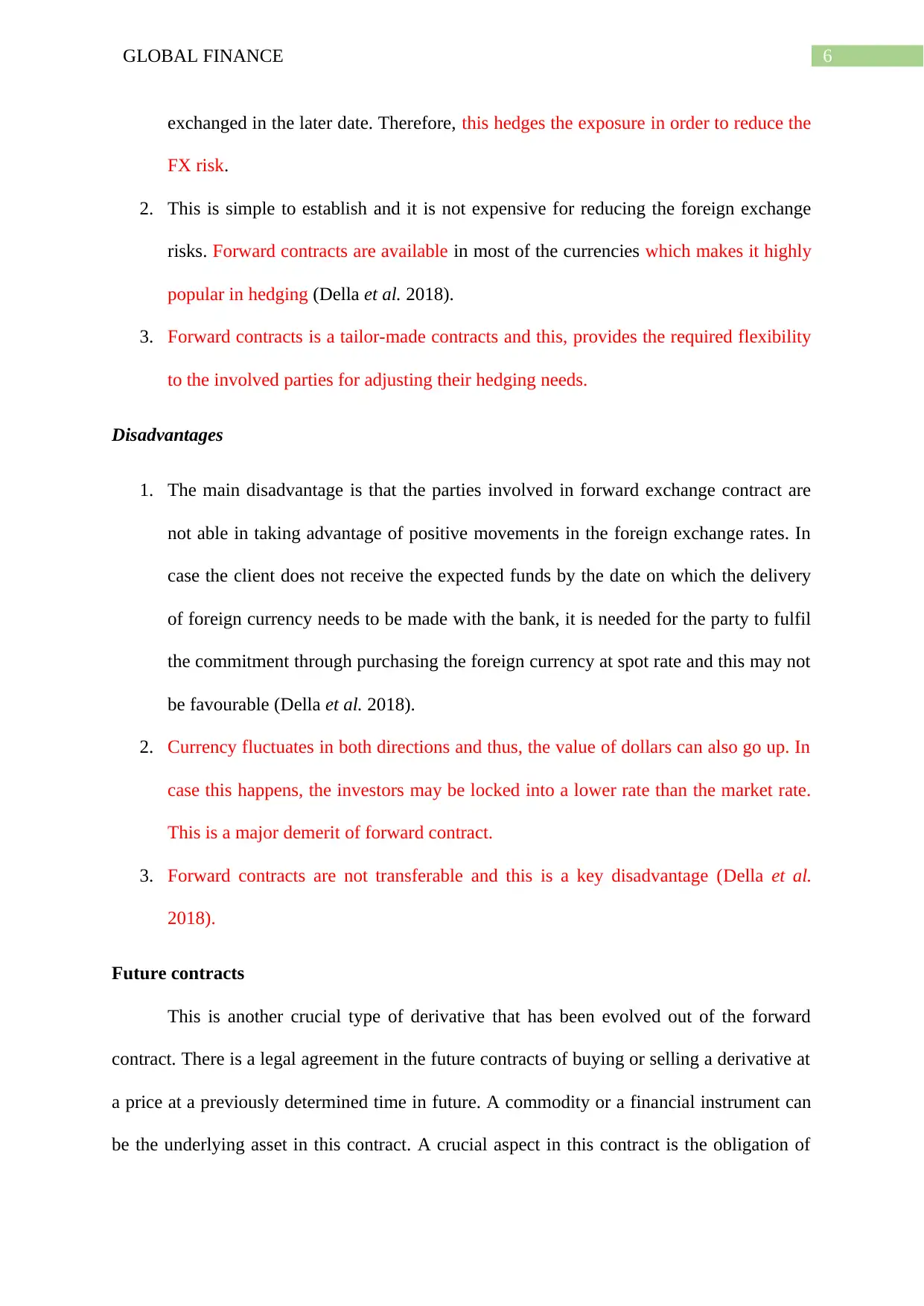
6GLOBAL FINANCE
exchanged in the later date. Therefore, this hedges the exposure in order to reduce the
FX risk.
2. This is simple to establish and it is not expensive for reducing the foreign exchange
risks. Forward contracts are available in most of the currencies which makes it highly
popular in hedging (Della et al. 2018).
3. Forward contracts is a tailor-made contracts and this, provides the required flexibility
to the involved parties for adjusting their hedging needs.
Disadvantages
1. The main disadvantage is that the parties involved in forward exchange contract are
not able in taking advantage of positive movements in the foreign exchange rates. In
case the client does not receive the expected funds by the date on which the delivery
of foreign currency needs to be made with the bank, it is needed for the party to fulfil
the commitment through purchasing the foreign currency at spot rate and this may not
be favourable (Della et al. 2018).
2. Currency fluctuates in both directions and thus, the value of dollars can also go up. In
case this happens, the investors may be locked into a lower rate than the market rate.
This is a major demerit of forward contract.
3. Forward contracts are not transferable and this is a key disadvantage (Della et al.
2018).
Future contracts
This is another crucial type of derivative that has been evolved out of the forward
contract. There is a legal agreement in the future contracts of buying or selling a derivative at
a price at a previously determined time in future. A commodity or a financial instrument can
be the underlying asset in this contract. A crucial aspect in this contract is the obligation of
exchanged in the later date. Therefore, this hedges the exposure in order to reduce the
FX risk.
2. This is simple to establish and it is not expensive for reducing the foreign exchange
risks. Forward contracts are available in most of the currencies which makes it highly
popular in hedging (Della et al. 2018).
3. Forward contracts is a tailor-made contracts and this, provides the required flexibility
to the involved parties for adjusting their hedging needs.
Disadvantages
1. The main disadvantage is that the parties involved in forward exchange contract are
not able in taking advantage of positive movements in the foreign exchange rates. In
case the client does not receive the expected funds by the date on which the delivery
of foreign currency needs to be made with the bank, it is needed for the party to fulfil
the commitment through purchasing the foreign currency at spot rate and this may not
be favourable (Della et al. 2018).
2. Currency fluctuates in both directions and thus, the value of dollars can also go up. In
case this happens, the investors may be locked into a lower rate than the market rate.
This is a major demerit of forward contract.
3. Forward contracts are not transferable and this is a key disadvantage (Della et al.
2018).
Future contracts
This is another crucial type of derivative that has been evolved out of the forward
contract. There is a legal agreement in the future contracts of buying or selling a derivative at
a price at a previously determined time in future. A commodity or a financial instrument can
be the underlying asset in this contract. A crucial aspect in this contract is the obligation of
Paraphrase This Document
Need a fresh take? Get an instant paraphrase of this document with our AI Paraphraser

7GLOBAL FINANCE
the buyer and seller for fulfilling the contract at the previously determined time and price that
are called as delivery time and future price respectively (Wystup 2017).
Advantages
1. High liquidity is one of the major advantages of future contracts as high liquidity is
offered by most of the future markets, especially for currencies, indexes and
commonly traded commodities. Therefore, the traders can enter and exit the market as
per their convenience.
2. Costs associated with this are low (Rogers, Scotti and Wright 2018).
3. It is easier to understand the pricing arrangement under future contract. Under the
cost-of-carry pricing model in future contract, the future price is similar to the current
spot price along with the cost to carry the underlying asset until the contract’s
maturity.
Disadvantages
1. Future contracts do not have any control on the future events which is regarded as a
main disadvantage of using this in FX.
2. High leverage can result in rapid fluctuations of future prices and this affects the FX
operations for the involved parties (Wystup 2017).
3. Certain expiration dates are involved in the future contracts; and a given asset’s
contracted price can become less attractive as the expiration date come nearer. This is
a disadvantage as the future contract may even expire and can become a valueless
investment.
Options contracts
Options are considered as such derivative contracts that provide the buyers with a
right of buying or selling the underlying assets at the predetermined price during a certain
the buyer and seller for fulfilling the contract at the previously determined time and price that
are called as delivery time and future price respectively (Wystup 2017).
Advantages
1. High liquidity is one of the major advantages of future contracts as high liquidity is
offered by most of the future markets, especially for currencies, indexes and
commonly traded commodities. Therefore, the traders can enter and exit the market as
per their convenience.
2. Costs associated with this are low (Rogers, Scotti and Wright 2018).
3. It is easier to understand the pricing arrangement under future contract. Under the
cost-of-carry pricing model in future contract, the future price is similar to the current
spot price along with the cost to carry the underlying asset until the contract’s
maturity.
Disadvantages
1. Future contracts do not have any control on the future events which is regarded as a
main disadvantage of using this in FX.
2. High leverage can result in rapid fluctuations of future prices and this affects the FX
operations for the involved parties (Wystup 2017).
3. Certain expiration dates are involved in the future contracts; and a given asset’s
contracted price can become less attractive as the expiration date come nearer. This is
a disadvantage as the future contract may even expire and can become a valueless
investment.
Options contracts
Options are considered as such derivative contracts that provide the buyers with a
right of buying or selling the underlying assets at the predetermined price during a certain

8GLOBAL FINANCE
time. There is not any obligation on the buyer for exercising the option. A premium or free is
imposed for involving into the options contracts. Both Call option and Put option is there.
Call option allows the buyers to buy the underlying asset at a previously determined
exchange price at or before the expiry date whereas a put option allows the buyer but not the
obligation in selling an underlying asset at a predetermined foreign exchange price at or
before the expiry date (Liu, Chen and Ralescu 2015).
Advantages
1. The main advantage is that the buyer has not need of committing exchange currency
at strike price and can also allow the options to be collapsed in case it is not
favourable for him/her. Moreover, the buyer can take out the option at any time
(Yavuz and Özdemir 2018).
2. Option contracts can be used for setting up complex volatility as well as time-
sensitive trades. An option trader can build a much more sophisticated trade through
buying and selling a combination of different calls and puts options at different strike
prices and expiration dates.
3. Option contracts help the traders in limiting the potential losses in case a trader wants
to stake against a stock. This reduced the exposure to potentially limitless losses
(Taušer and Čajka 2016).
Disadvantages
1. It is a costly matter to hedge through currency options as the cost would be around
nearly sale as 5% of the total amount of foreign exchange covered. In case of the
tailor made options, lack of negotiability can be seen (Yavuz and Özdemir 2018).
2. As there is lack of liquidity, higher spread can be seen in option contracts. This
increases the indirect costs of the traders and this is a key disadvantage.
time. There is not any obligation on the buyer for exercising the option. A premium or free is
imposed for involving into the options contracts. Both Call option and Put option is there.
Call option allows the buyers to buy the underlying asset at a previously determined
exchange price at or before the expiry date whereas a put option allows the buyer but not the
obligation in selling an underlying asset at a predetermined foreign exchange price at or
before the expiry date (Liu, Chen and Ralescu 2015).
Advantages
1. The main advantage is that the buyer has not need of committing exchange currency
at strike price and can also allow the options to be collapsed in case it is not
favourable for him/her. Moreover, the buyer can take out the option at any time
(Yavuz and Özdemir 2018).
2. Option contracts can be used for setting up complex volatility as well as time-
sensitive trades. An option trader can build a much more sophisticated trade through
buying and selling a combination of different calls and puts options at different strike
prices and expiration dates.
3. Option contracts help the traders in limiting the potential losses in case a trader wants
to stake against a stock. This reduced the exposure to potentially limitless losses
(Taušer and Čajka 2016).
Disadvantages
1. It is a costly matter to hedge through currency options as the cost would be around
nearly sale as 5% of the total amount of foreign exchange covered. In case of the
tailor made options, lack of negotiability can be seen (Yavuz and Özdemir 2018).
2. As there is lack of liquidity, higher spread can be seen in option contracts. This
increases the indirect costs of the traders and this is a key disadvantage.
⊘ This is a preview!⊘
Do you want full access?
Subscribe today to unlock all pages.

Trusted by 1+ million students worldwide
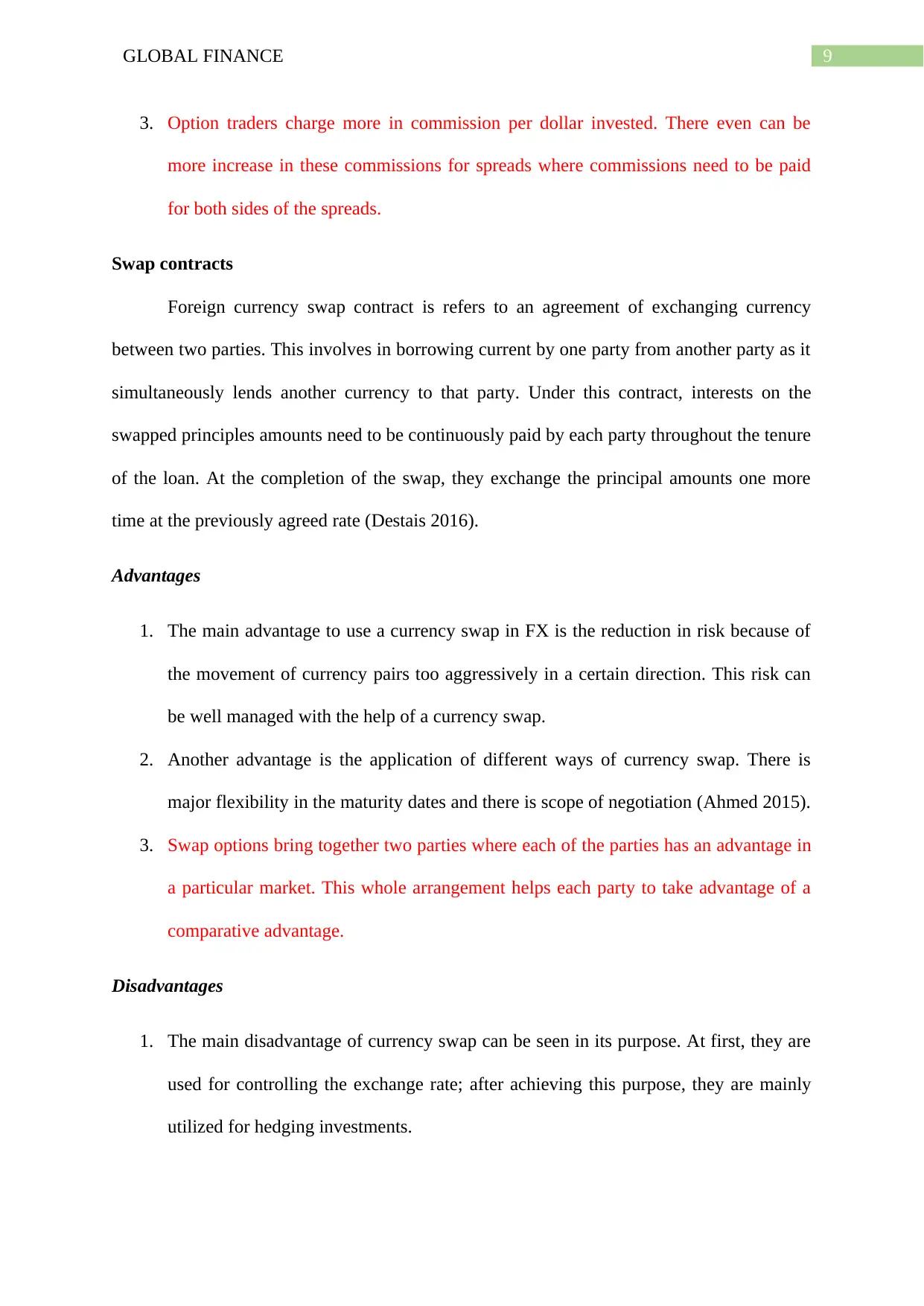
9GLOBAL FINANCE
3. Option traders charge more in commission per dollar invested. There even can be
more increase in these commissions for spreads where commissions need to be paid
for both sides of the spreads.
Swap contracts
Foreign currency swap contract is refers to an agreement of exchanging currency
between two parties. This involves in borrowing current by one party from another party as it
simultaneously lends another currency to that party. Under this contract, interests on the
swapped principles amounts need to be continuously paid by each party throughout the tenure
of the loan. At the completion of the swap, they exchange the principal amounts one more
time at the previously agreed rate (Destais 2016).
Advantages
1. The main advantage to use a currency swap in FX is the reduction in risk because of
the movement of currency pairs too aggressively in a certain direction. This risk can
be well managed with the help of a currency swap.
2. Another advantage is the application of different ways of currency swap. There is
major flexibility in the maturity dates and there is scope of negotiation (Ahmed 2015).
3. Swap options bring together two parties where each of the parties has an advantage in
a particular market. This whole arrangement helps each party to take advantage of a
comparative advantage.
Disadvantages
1. The main disadvantage of currency swap can be seen in its purpose. At first, they are
used for controlling the exchange rate; after achieving this purpose, they are mainly
utilized for hedging investments.
3. Option traders charge more in commission per dollar invested. There even can be
more increase in these commissions for spreads where commissions need to be paid
for both sides of the spreads.
Swap contracts
Foreign currency swap contract is refers to an agreement of exchanging currency
between two parties. This involves in borrowing current by one party from another party as it
simultaneously lends another currency to that party. Under this contract, interests on the
swapped principles amounts need to be continuously paid by each party throughout the tenure
of the loan. At the completion of the swap, they exchange the principal amounts one more
time at the previously agreed rate (Destais 2016).
Advantages
1. The main advantage to use a currency swap in FX is the reduction in risk because of
the movement of currency pairs too aggressively in a certain direction. This risk can
be well managed with the help of a currency swap.
2. Another advantage is the application of different ways of currency swap. There is
major flexibility in the maturity dates and there is scope of negotiation (Ahmed 2015).
3. Swap options bring together two parties where each of the parties has an advantage in
a particular market. This whole arrangement helps each party to take advantage of a
comparative advantage.
Disadvantages
1. The main disadvantage of currency swap can be seen in its purpose. At first, they are
used for controlling the exchange rate; after achieving this purpose, they are mainly
utilized for hedging investments.
Paraphrase This Document
Need a fresh take? Get an instant paraphrase of this document with our AI Paraphraser
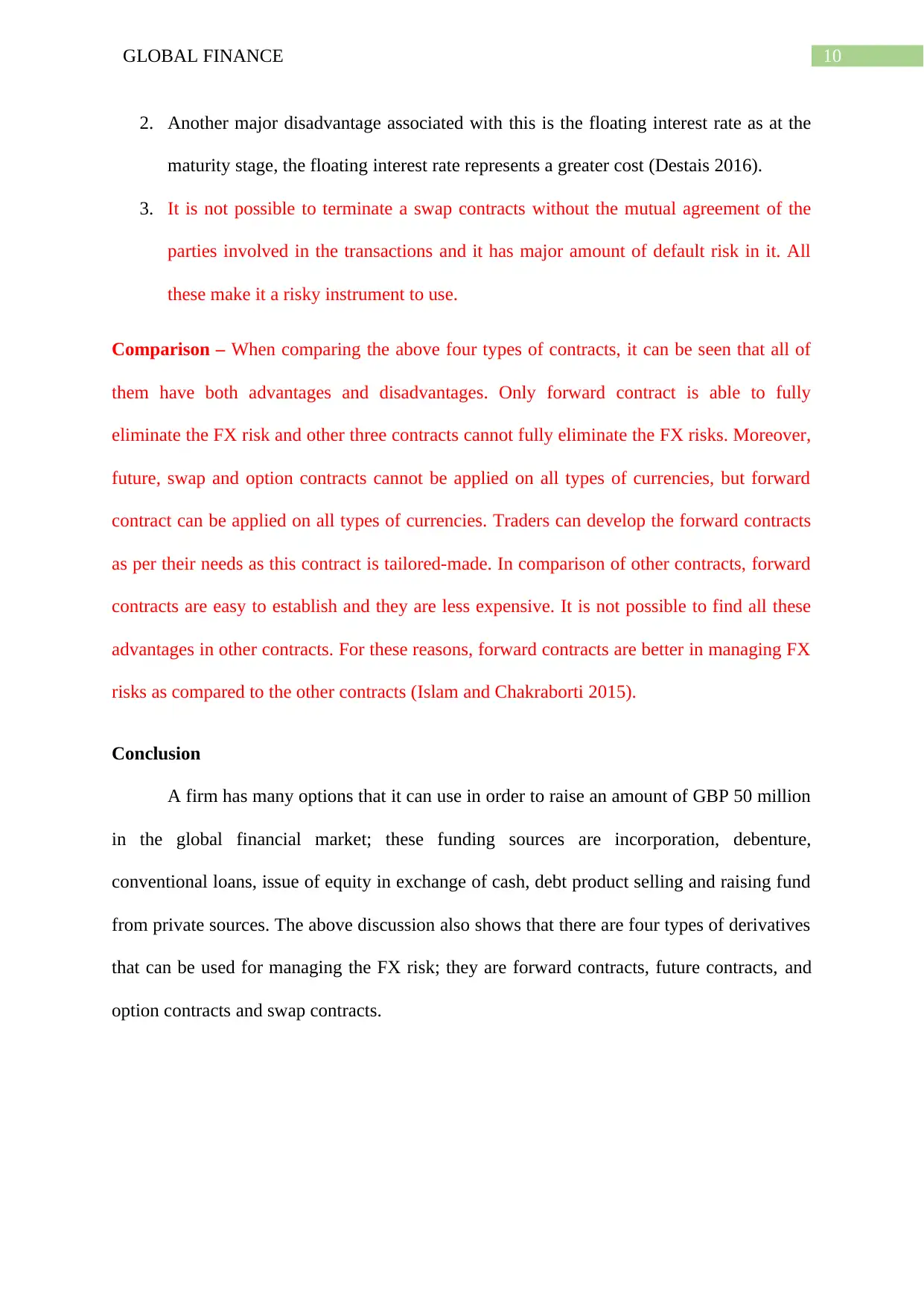
10GLOBAL FINANCE
2. Another major disadvantage associated with this is the floating interest rate as at the
maturity stage, the floating interest rate represents a greater cost (Destais 2016).
3. It is not possible to terminate a swap contracts without the mutual agreement of the
parties involved in the transactions and it has major amount of default risk in it. All
these make it a risky instrument to use.
Comparison – When comparing the above four types of contracts, it can be seen that all of
them have both advantages and disadvantages. Only forward contract is able to fully
eliminate the FX risk and other three contracts cannot fully eliminate the FX risks. Moreover,
future, swap and option contracts cannot be applied on all types of currencies, but forward
contract can be applied on all types of currencies. Traders can develop the forward contracts
as per their needs as this contract is tailored-made. In comparison of other contracts, forward
contracts are easy to establish and they are less expensive. It is not possible to find all these
advantages in other contracts. For these reasons, forward contracts are better in managing FX
risks as compared to the other contracts (Islam and Chakraborti 2015).
Conclusion
A firm has many options that it can use in order to raise an amount of GBP 50 million
in the global financial market; these funding sources are incorporation, debenture,
conventional loans, issue of equity in exchange of cash, debt product selling and raising fund
from private sources. The above discussion also shows that there are four types of derivatives
that can be used for managing the FX risk; they are forward contracts, future contracts, and
option contracts and swap contracts.
2. Another major disadvantage associated with this is the floating interest rate as at the
maturity stage, the floating interest rate represents a greater cost (Destais 2016).
3. It is not possible to terminate a swap contracts without the mutual agreement of the
parties involved in the transactions and it has major amount of default risk in it. All
these make it a risky instrument to use.
Comparison – When comparing the above four types of contracts, it can be seen that all of
them have both advantages and disadvantages. Only forward contract is able to fully
eliminate the FX risk and other three contracts cannot fully eliminate the FX risks. Moreover,
future, swap and option contracts cannot be applied on all types of currencies, but forward
contract can be applied on all types of currencies. Traders can develop the forward contracts
as per their needs as this contract is tailored-made. In comparison of other contracts, forward
contracts are easy to establish and they are less expensive. It is not possible to find all these
advantages in other contracts. For these reasons, forward contracts are better in managing FX
risks as compared to the other contracts (Islam and Chakraborti 2015).
Conclusion
A firm has many options that it can use in order to raise an amount of GBP 50 million
in the global financial market; these funding sources are incorporation, debenture,
conventional loans, issue of equity in exchange of cash, debt product selling and raising fund
from private sources. The above discussion also shows that there are four types of derivatives
that can be used for managing the FX risk; they are forward contracts, future contracts, and
option contracts and swap contracts.
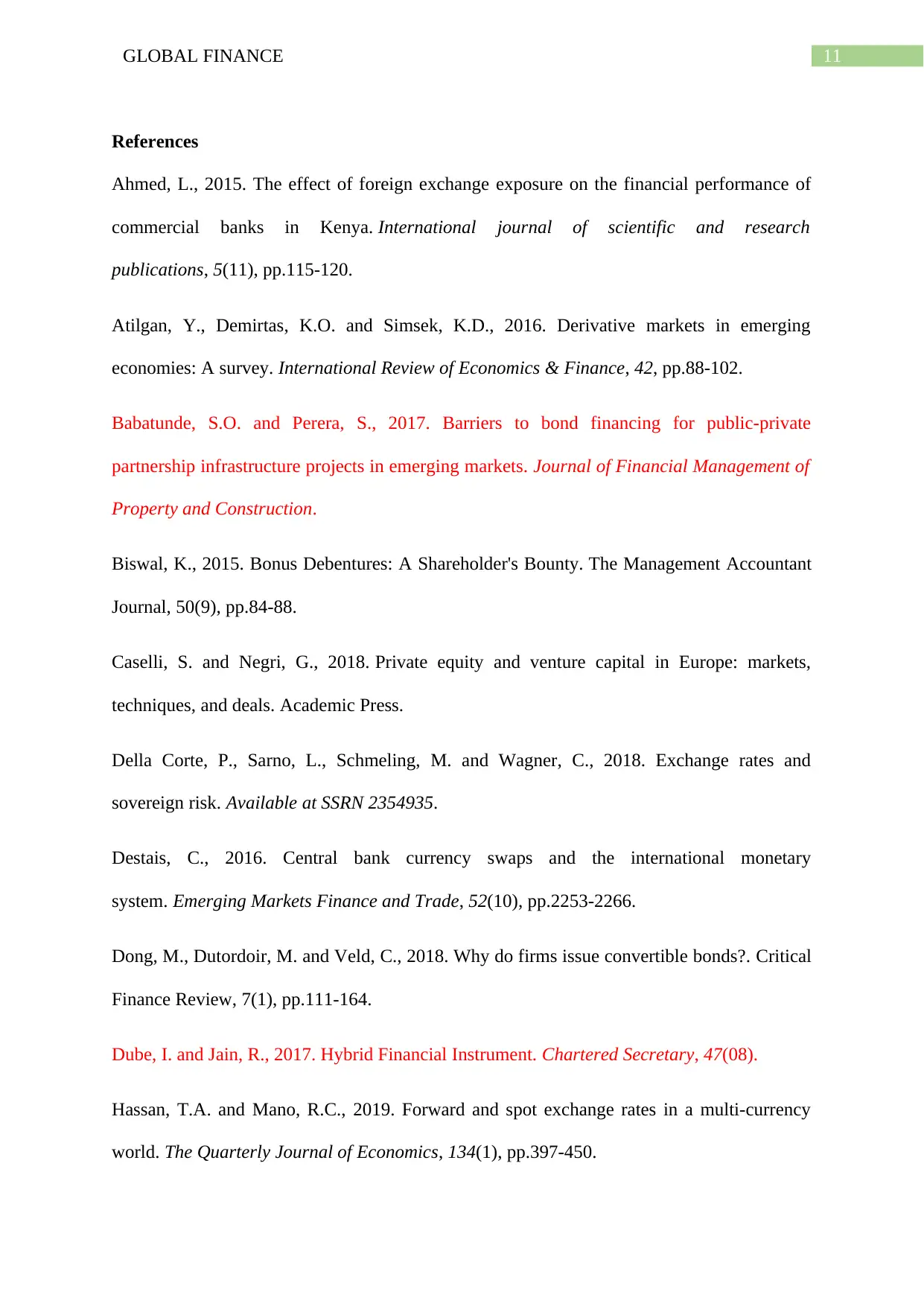
11GLOBAL FINANCE
References
Ahmed, L., 2015. The effect of foreign exchange exposure on the financial performance of
commercial banks in Kenya. International journal of scientific and research
publications, 5(11), pp.115-120.
Atilgan, Y., Demirtas, K.O. and Simsek, K.D., 2016. Derivative markets in emerging
economies: A survey. International Review of Economics & Finance, 42, pp.88-102.
Babatunde, S.O. and Perera, S., 2017. Barriers to bond financing for public-private
partnership infrastructure projects in emerging markets. Journal of Financial Management of
Property and Construction.
Biswal, K., 2015. Bonus Debentures: A Shareholder's Bounty. The Management Accountant
Journal, 50(9), pp.84-88.
Caselli, S. and Negri, G., 2018. Private equity and venture capital in Europe: markets,
techniques, and deals. Academic Press.
Della Corte, P., Sarno, L., Schmeling, M. and Wagner, C., 2018. Exchange rates and
sovereign risk. Available at SSRN 2354935.
Destais, C., 2016. Central bank currency swaps and the international monetary
system. Emerging Markets Finance and Trade, 52(10), pp.2253-2266.
Dong, M., Dutordoir, M. and Veld, C., 2018. Why do firms issue convertible bonds?. Critical
Finance Review, 7(1), pp.111-164.
Dube, I. and Jain, R., 2017. Hybrid Financial Instrument. Chartered Secretary, 47(08).
Hassan, T.A. and Mano, R.C., 2019. Forward and spot exchange rates in a multi-currency
world. The Quarterly Journal of Economics, 134(1), pp.397-450.
References
Ahmed, L., 2015. The effect of foreign exchange exposure on the financial performance of
commercial banks in Kenya. International journal of scientific and research
publications, 5(11), pp.115-120.
Atilgan, Y., Demirtas, K.O. and Simsek, K.D., 2016. Derivative markets in emerging
economies: A survey. International Review of Economics & Finance, 42, pp.88-102.
Babatunde, S.O. and Perera, S., 2017. Barriers to bond financing for public-private
partnership infrastructure projects in emerging markets. Journal of Financial Management of
Property and Construction.
Biswal, K., 2015. Bonus Debentures: A Shareholder's Bounty. The Management Accountant
Journal, 50(9), pp.84-88.
Caselli, S. and Negri, G., 2018. Private equity and venture capital in Europe: markets,
techniques, and deals. Academic Press.
Della Corte, P., Sarno, L., Schmeling, M. and Wagner, C., 2018. Exchange rates and
sovereign risk. Available at SSRN 2354935.
Destais, C., 2016. Central bank currency swaps and the international monetary
system. Emerging Markets Finance and Trade, 52(10), pp.2253-2266.
Dong, M., Dutordoir, M. and Veld, C., 2018. Why do firms issue convertible bonds?. Critical
Finance Review, 7(1), pp.111-164.
Dube, I. and Jain, R., 2017. Hybrid Financial Instrument. Chartered Secretary, 47(08).
Hassan, T.A. and Mano, R.C., 2019. Forward and spot exchange rates in a multi-currency
world. The Quarterly Journal of Economics, 134(1), pp.397-450.
⊘ This is a preview!⊘
Do you want full access?
Subscribe today to unlock all pages.

Trusted by 1+ million students worldwide
1 out of 13
Related Documents
Your All-in-One AI-Powered Toolkit for Academic Success.
+13062052269
info@desklib.com
Available 24*7 on WhatsApp / Email
![[object Object]](/_next/static/media/star-bottom.7253800d.svg)
Unlock your academic potential
Copyright © 2020–2025 A2Z Services. All Rights Reserved. Developed and managed by ZUCOL.



